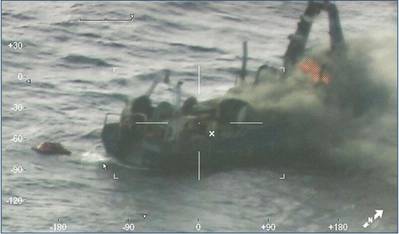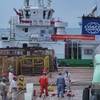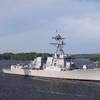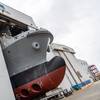Hydraulic Hose Failure Sparked Fishing Vessel Fire -NTSB
A hydraulic hose failure led to an engine room fire aboard a fishing vessel off the coast of Massachusetts, the National Transportation Safety Board (NTSB) said Thursday.
Marine Investigation Report 22/13 details the NTSB’s investigation into the April 30, 2021, fire board the fishing vessel Nobska. The five-member crew was ground fishing in Georges Banks, about 80 miles east of Cape Cod, Massachusetts, when a fire started in the engine room and quickly engulfed the vessel. After unsuccessful attempts to extinguish the fire, the crew prepared to abandon ship and activated the vessel’s emergency position indicating radio beacon. A U.S. Coast Guard helicopter rescued the crew from the stern of the vessel. No pollution or injuries were reported. The vessel was declared a total loss at an estimated $2.4 million.
On April 30, while fishing for haddock, the crew saw a fire in the engine room on the lagging of the main engine exhaust pipe. After extinguishing the fire, the crew discovered a ruptured hydraulic hose nearby in the pipe/hose tunnel connecting the engine room to the wheelhouse. The leaking hydraulic fluid was determined to be the fuel source of the fire. The crew removed the damaged hydraulic hose and replaced it with a similar sized one. They also removed the oil-soaked lagging on the main engine exhaust pipe but did not replace it. Thinking the situation with the hydraulic system was resolved, the captain decided to continue fishing.
Four hours later, the captain noticed black smoke coming from under the deck winch-control console in the wheelhouse. The captain alerted the crew of the fire and within moments the wheelhouse area was engulfed in flames. The crew was unable to extinguish the fire and abandoned ship.
The second fire resulted in extensive damage throughout the vessel and was likely the result of another hydraulic hose leak, when atomized fluid contacted a hot surface, most likely the exposed main engine exhaust pipe, and flashed into a fire.
The NTSB determined the probable cause of the fire aboard the Nobska was a failure of a hydraulic hose within the engine room that allowed hydraulic fluid to spray onto a hot surface, likely the exposed main engine exhaust pipe. Contributing to the failure of the hydraulic hose was possible heat damage from a fire that occurred earlier in the day.
“The pipe/hose tunnel on board the Nobska, which extended from the engine room up two decks to the wheelhouse, did not have any insulation, pipe/cable fire stops, or other barriers to prevent the passage of smoke, heat, and fire—known as structural fire protection,” the report said. “This type of unprotected vertical tunnel has the potential to provide a pathway for fires to spread quickly outside of the space of origination. Vessel owners and operators should identify such openings between decks and ensure they are structurally fire protected to prevent the spread of a fire.”
Improving fishing vessel safety remains a priority for the NTSB and it is an issue on the NTSB’s 2021-2022 Most Wanted List of Transportation Safety Improvements. The NTSB advocates for new standards to address—and periodically reassess—intact stability, subdivision, and watertight integrity in commercial fishing vessels up to 79 feet long.













